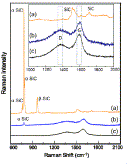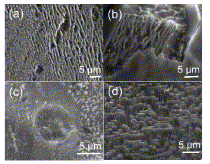Synthesis of carbon films by electrochemical etching of SiC with hydrofluoric acid in nonaqueous solvents*
Jaganathan Senthilnathana, Chih-Chiang Wenga, Wen-Ta Tsaia, Yury Gogotsib,  , Masahiro Yoshimuraa,
, Masahiro Yoshimuraa,
a Promotion Centre for Global Materials Research (PCGMR), Department of Material Science and Engineering, National Cheng Kung University, Tainan, Taiwan
b Department of Materials Science and Engineering, and A. J. Drexel Nanotechnology Institute, Drexel University, Philadelphia, PA 19104, USA
*In Press, Accepted Manuscript, Available online 24 January 2014, http://dx.doi.org/10.1016/j.carbon.2014.01.028
Abstract
Carbon films on SiC have many applications, ranging from tribology to electrical energy storage. Formation of epitaxial or heteroepitaxial layers of carbon on SiC by “soft solution process,” such as electro- or photochemical ones, are attractive for various fields of application, decreasing the energy consumption and making the process compatible with electronic device fabrication. We have demonstrated formation of a carbon layer on SiC ceramics by electrochemical etching in a nonaqueous electrolyte. The selective etching of Si from SiC in a single step reaction with hydrofluoric acid (HF) in different organic solvents has been carried out and the role of polarity, surface tension, density, and viscosity of the organic solvents in the formation of the carbon layer has been investigated. The solution of 1:4.6 ratio HF and ethanol at low current densities (10 and 20 mA/cm2) allows the best control over selective etching of Si forming amorphous and ordered carbon on the SiC surface. The presence of an intense G band of graphitic carbon in Raman spectra and high resolution transmission electron microscopy analysis indicate formation of ordered carbon on the surface of SiC. X-ray diffraction shows that the etching rate of α-SiC is much higher when compared to β-SiC.
|

|
|

|
|
Fig. 1. Raman spectra of unetched and etched SiC. (a) Unetched SiC (b) Etched at 10 mA/cm2, (c) Etched at 20 mA/cm2. Note: G = graphite band; D = disorder induced band; Inset shows the magnified carbon range of Raman spectra of samples etched at 10 and 20 mA/cm2 current densities
|
|
Fig. 2. SEM images of SiC etched with HF solutions in different solvents at fixed current densities 10 mA/cm2 (a) acetonitrile (b) acetone (c) water (d) isopropanol
|
Source: www.mrc.org.ua